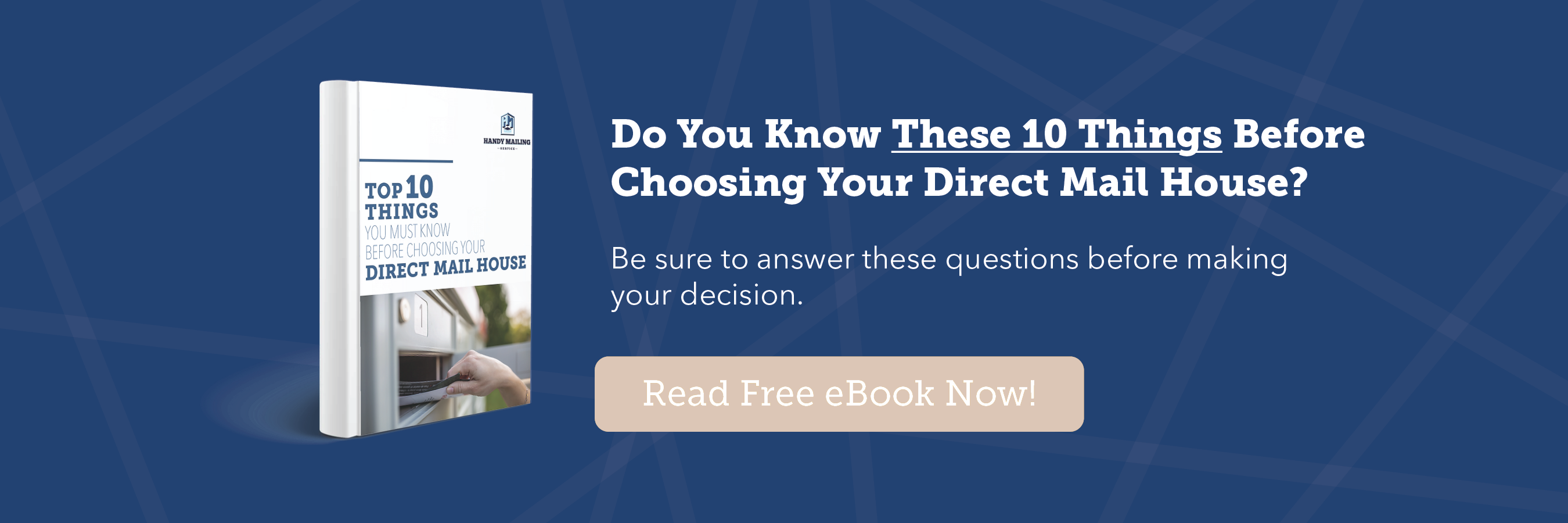To maintain maximum productivity, it’s important you install the right systems. These systems need to contribute to the overall effectiveness of your operation while requiring the least amount of thinking and manpower possible. By having the right systems in place, your direct mail campaigns will be more manageable and profitable than ever. You’ll notice two changes:
First, it reduces stress. You don’t need to constantly ask, “Where are we at here?” Or “Did we get this done.” You know it’s done because your system tells you it’s done.
Second, it saves money. Because you’ll be more efficient, you’ll save time and money by not making as many mistakes during the process.
Here are five things you can implement to streamline your direct mail process and start getting higher returns on your direct mail.

Clean Your List
An important place to start is to clean your list. You probably already know the list forms at least 40 percent of your direct mail campaign. There are two ways to do this.
First, go through each address, line by line, and ensure each record is up to date. Since you’re a small business, you probably don’t have a monstrous list. It might take an afternoon or two to get this done, but, believe me, the payoff is worth it.
Second, use list software. If you have a large list, with records in the thousands (even tens of thousands), then going through each record manually won’t cut it. Instead, you need to use list software. Try this online here.
Don’t Reinvent the Wheel
“Good artists borrow. Great artists steal.”
This is what you should think of when you’re planning direct mail campaigns. You don’t have to re-create anything unless you want to. In fact, this is one of the best ways to streamline your direct mail process. This will save you time and A LOT of frustration. Take what’s been done before you and “swipe” it.
If you receive something clever in the mail, take notice of it and keep it for later. Then in the brainstorming phase, think about how you can adapt those same strategies to your piece. There’s nothing wrong with using something successful as the framework for your mail piece.
You Can Never Plan Too Much
You know the phrase, “Every minute in planning saves in 10 minutes in execution.” It’s no different when you are planning your direct mail campaign. Truly, you can never plan too much!
But how do you plan? What is the most effective way?
Begin with the end in mind. Ask yourself: “What results do I want to achieve with this mail piece?” Once you nail down the answer to this question, the rest is easy. But you must answer this question first or you can waste a whole lot of time and brainpower on unfocused planning.
Begin with the end in mind. Ask yourself: “What results do I want to achieve with this mail piece?”
With that in mind, you can begin to come up with the mail piece. Is this going to be a newsletter, a card, an envelope? Which type of mail piece will most resonate with your list? This can take a long time because of issues related to each media. We’ve mentioned in depth some advantage and disadvantages of these in other posts and article, so I won’t dive in here.
Once you land on the type of mailer, it’s time to delegate out the roles. Don’t bear all the work on your shoulders – you don’t want to get burned out from the start. Here are some things you need to delegate from the outset.
- Who’s in charge of design?
- Who’s in charge of writing copy?
- Who’s in charge of printing and fulfillment?
These three points are the main concerns you need to address. Put one person in charge of each of these. Just one. If you have more than one person, there’s a temptation to not take charge. Remember those history projects in grade school and middle school, where the teacher formed groups? Remember how one person did all the work and the slackers still received credit? Same thing here. One person only.
Now, that doesn't mean this person in charge needs to do all the work; he or she just needs to facilitate the process, ensuring each piece is where it needs to be when it needs to be.
Easy Ways to Track
If you’re a direct mail veteran, then you probably know the importance of tracking each mail piece. Nothing more needs to be said here.
But if you’re new, tracking forms a core component of direct mail success. Let’s talk about various ways to do this.
The simplest way is to use pen and paper. As people begin responding to your mail piece, whether through a return envelope or a from a website form, track on a sheet of paper who and when, as well any other essential information you might have included in your letter. If you’re split testing your mailing, be sure to include which list the person came from.
If you’re allergic to pen and paper, try going digital. I’d recommend this for because of its ease of entry and organization and search capabilities. It’s also easier to store and organize for when you will need it in the future. You can use either Google Sheets or Microsoft Excel, both of which do essentially the same thing. The only advantage of Google Sheets over Excel is the ability to share with others and access it anywhere.
Both of these are great, but there is one more option I’d recommend. If you have a website and have the ability to track clicks on your website, I’d recommend placing a call to action on your mail piece and directing all traffic to the website.
For example, let’s say you’re selling diet pills. You could include in your mailer the option of filling out a paper form and returning the form via direct mail back to you. This works and a lot of small businesses still do this. But if you’re not convinced this is the best way, then try instead including a URL on your mail piece. The said URL will direct them to a form the person can fill in with order information for whatever you’re selling. That’s reason enough to do it – the convenience! But it has the added benefit of giving you tracking information for all responders.
Outsource to a Mailhouse
As a small business owner or someone in charge of marketing for your small business, you probably already wear too many hats. Whether it’s taking care of customers or fulfilling orders, you probably don’t have a lot of time to do create AND fulfill direct mail campaigns. If it’s too much to manage the printing and mailing portion of your direct mail marketing, consider handing over that portion to a mail house.
What will a mailhouse do for you?
They will print your art files, clean and reformat your mailing list, and they will mail your direct mail campaign. This will save you a lot of time, but it will also save you money. How so?
First, they will take your mailing list and remove the undeliverable addresses as well as correct the ones will faulty street numbers. This cuts down of wasted printing and postage.
Second, they will reduce your postage costs by presorting the mail for the post office. The post office gives reduced postage costs for companies that sort their mail prior to it coming into the post office.
Third, since you’re a small business you probably don’t have industrial printers and mailing equipment/software to fulfill your mail. But a mailhouse does. This means you don’t need to use your staff for stuffing envelopes or writing out addresses or wasting time trying to manually presort a list.



